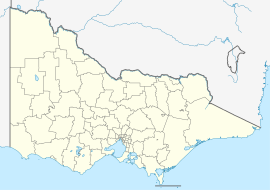Ballarat
|
Ballarat Victoria |
|||||||||
|---|---|---|---|---|---|---|---|---|---|
From top left to bottom right: Panorama of Ballarat from Black Hill, rowers on Lake Wendouree, Ballarat Botanical Gardens, the Ballarat Town Hall, Her Majesty's Theatre, Lydiard Street and former Post Office and the Arch of Victory and Avenue of Honour
|
|||||||||
| Coordinates | 37°33′0″S 143°51′0″E / 37.55000°S 143.85000°ECoordinates: 37°33′0″S 143°51′0″E / 37.55000°S 143.85000°E | ||||||||
| Population | 99,841 (2015) (17th) | ||||||||
| • Density | 290.57/km2 (752.58/sq mi) | ||||||||
| Established | 1838 | ||||||||
| Postcode(s) | 3350 | ||||||||
| Elevation | 435 m (1,427 ft) AHD | ||||||||
| Area | 343.6 km2 (132.7 sq mi) (2011 census – urban area) | ||||||||
| Time zone | AEST (UTC+10) | ||||||||
| • Summer (DST) | AEDT (UTC+11) | ||||||||
| Location | |||||||||
| LGA(s) | City of Ballarat | ||||||||
| State electorate(s) | |||||||||
| Federal Division(s) | Ballarat | ||||||||
|
|||||||||
Ballarat /ˈbæləræt/ is a city located on the Yarrowee River in the Grampians region of Victoria, Australia. The city is approximately 105 kilometres (65 mi) west-north-west of the state capital, Melbourne, with a population of some 99,841. It is the third largest population for an inland city in Australia. Locals are known as 'Ballaratians'.
Ballarat is arguably the most significant Victorian era gold rush boomtowns in Australia. Just months after Victoria was granted separation from the state of New South Wales, the Victorian gold rush transformed Ballarat from a small sheep station to a major settlement. Gold was discovered at Poverty Point on 18 August 1851, and news quickly spread of rich alluvial fields where gold could easily be extracted. Within months, migrants from across the world had rushed to the district in search of gold. Unlike many other gold boom towns, the Ballarat fields experienced sustained high gold yields for many decades, which can be evidenced to this day in the city's rich architecture.
The Eureka Rebellion began in Ballarat, and the only armed rebellion in Australian history, the Battle of Eureka Stockade, took place on 3 December 1854. In response to the event the first male suffrage in Australia was instituted and as such Eureka is interpreted by some as the origin of democracy in Australia. The gold rush and boom gave birth to many other significant cultural legacies. The rebellion's symbol, the Eureka Flag, has become a national symbol and is held at the Museum of Australian Democracy at Eureka in Ballarat. Other nationally significant heritage structures include the Ballarat Botanical Gardens (established 1857), with the greatest concentration of public statuary, the official Prime Ministers Avenue, the longest running lyric theatre building (Her Majesty's Theatre, established 1875), the first municipal observatory, established 1886, and the earliest and longest war memorial avenue (the Avenue of Honour, established between 1917 and 1919).
...
Wikipedia








